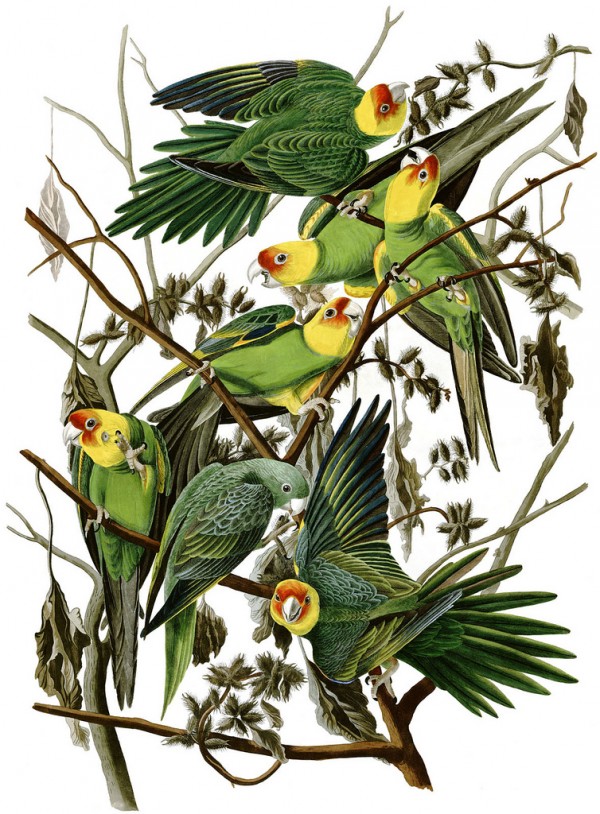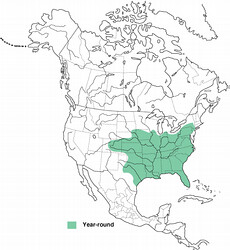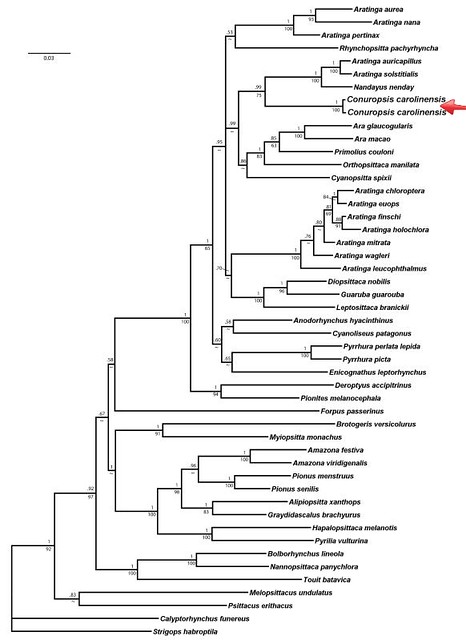Journal Club: Extinct Carolina parakeet provides glimpse into evolution of American parrots

SUMMARY: DNA obtained for the first time from extinct Carolina parakeets reveals their closest relatives and provides insight into the evolution of New World parrots
.. .. .. .. .. .. .. .. .. .. ..

 The Carolina parakeet, Conuropsis carolinensis (pictured above), was the only endemic parrot in the United States. It had one of the most northerly ranges of any parrot species, even occurring along the southern shores of Lake Ontario (see range map, right; doi:10.2173/bna.667). But European settlers quickly persecuted this colourful and widespread parrot out of existence for food, feathers, “sport” and to protect their crops. By the early 1920s, this common parrot was gone forever.
The Carolina parakeet, Conuropsis carolinensis (pictured above), was the only endemic parrot in the United States. It had one of the most northerly ranges of any parrot species, even occurring along the southern shores of Lake Ontario (see range map, right; doi:10.2173/bna.667). But European settlers quickly persecuted this colourful and widespread parrot out of existence for food, feathers, “sport” and to protect their crops. By the early 1920s, this common parrot was gone forever.
So efficient was this extermination campaign that the Carolina parakeet disappeared before we knew much about its ecology and behaviours. The little that we do know about these iconic birds’ life history and historical distribution comes from modern scientists, ornithologists and historians stitching together brief snippets penned by 19th century naturalists with personal observations reported by the few still-living people who knew this bird in life.
Also mysterious are the precise evolutionary relationships between the Carolina parakeet and other neotropical parrots species. Although this parrot is the only member of its genus, Conuropsis, its long, pointed tail and wings, feathered cheeks and lores, the combination of yellow and orange head plumage and blue feathers in its wings, and its comparatively broad and heavy bill closely resemble these same features in several parrots in the genus Aratinga, leading most authorities to argue they are close relatives.
But other authorities have pointed out that the Carolina parakeet’s fully feathered ceres, that fleshy area surrounding its nostrils, is a trait shared with the monk parakeet, Myiopsitta monachus (doi:10.2173/bna.667), a parrot that still lives in temperate South America. For this reason, it has been proposed that the Carolina and monk parakeets may be sister species — each other’s closest relatives.
This controversy gives rise to questions about the evolutionary relationships between New World parrot species as well as about the process of evolution in general, such as; which of these characters are shared due to relatedness and which are the result of convergent evolution from having to deal with similar ecological challenges? What do these similar traits tell us about the ecology of these parrots? What can we learn about an extinct species after clarifying its evolutionary relationships with extant, or still-living, species?
To elucidate the evolutionary relationships between these parrots, a collaboration was forged between Jeremy Kirchman, Curator of Ornithology at the New York State Museum in Albany, and Erin Schirtzinger (who was a graduate student at the time) and her thesis advisor, Timothy Wright, a professor of biology at New Mexico State University in Las Cruces. The team isolated and sequenced the DNA from toepad tissue obtained from two museum specimens of the extinct Carolina parakeet. These DNA sequences totalled 876 nucleotides (nts) and comprised portions of two mitochondrial genes: COI (251 nts) and ND2 (625 nts). These gene sequences were aligned with the same DNA segments from 47 other parrot species, 43 of which are neotropical parrot species.
Statistical analyses of the nucleotide differences between these aligned sequences and subsequent reconstruction of the New World parrot family tree indicates that the Carolina parakeet is part of a well-supported group, or clade, of neotropical parakeets (figure 1):

Fig 1. Phylogram of relationships among extinct Carolina Parakeet, 43 extant species of Neotropical parrots, and 4 Old World parrots, based on a six-partition mixed-model Bayesian analysis of sequences from the mitochondrial COI & ND2 genes. Nodal support values indicate maximum likelihood (ML) bootstraps (below branch) & Bayesian posterior probabilities (above branch). Tildes (~) indicate ML bootstrap support values .. .. .. .. .. .. .. .. .. .. ..
As you can see in the above phylogram, the analyses strongly indicated that the Carolina parakeet (red arrow) is the sister species to a well-supported triad of sampled species, including; the mostly yellow-and-orange sun parakeet, Aratinga solstitialis, the golden-capped parakeet, A. auricapillus, a green parrot with an orange-and-yellow forehead, and the nanday parakeet, Nandayus nenday, a green parrot with a black head and neck. These similarities suggest that this striking plumage coloration evolved in the shared ancestor of this lineage and was partially lost by the nanday parakeet, which retains its blue primaries but has replaced (or obscured) the yellow-and-orange head and neck plumage with black.
A close look at the phylogram above (see detail below) makes it obvious that the Aratinga are scattered all over this family tree, indicating this particular genus is highly polyphyletic — which is how scientists describe a taxonomic mess that will require some serious work to resolve (PhD project, anyone?).

Figure 1. (Detail)
.. .. .. .. .. .. .. .. .. .. ..
But at the same time, if you dig out your magnifying glass and examine the original phylogram closely (figure 1), you’ll see that the relationship between the Carolina parakeet and the monk parakeet is not at all close. This indicates that one physical trait, feathered ceres, is the result of convergent evolution — possibly an adaptation for cold tolerance that evolved independently in both species.
This DNA detective work underscores other similarities, too. For example, wild sun parakeets are quite gregarious, roosting communally in tree cavities either by day or night — a behaviour reported for extinct Carolina parakeets, too.
I chose to share this story with you because even though the Carolina parakeet is extinct, we still can salvage some of this species’ history despite its tragic loss. For example, these data help bring into focus a larger question: how did the ancestor of the Carolina parakeet colonize temperate North America? Let’s take a peek at the range data for this species and its relatives. The Carolina parakeet’s closest living relatives are widely distributed across temperate and tropical South America, whilst those Aratinga species occurring in Mexico, other parts of Central America, or in the Greater Antilles are more distant relations. Since the Carolina parakeets’ more distant relations are geographically closer to its own historic range whilst its closest relatives are more geographically distant to it, these data are consistent with the generally accepted scientific idea that Central and North America were colonized at different times by distinct lineages of parrots — parrots that originally invaded South America from Antarctica (doi:10.1111/j.1365-2699.2011.02555.x). Fossil data, although sparse, lends support to this idea.
What drove these ancestral parrots to roam so widely at different times? An independent line of research published by Manuel Schweizer, Ole Seehausen and Stefan Hertwig provides some insight (doi:10.1111/j.1365-2699.2011.02555.x). In this fascinating paper, Schweizer’s team analyzed portions of two nuclear (chromosomal) genes to estimate the phylogenetic relationships between 75 parrot and 21 other avian taxa. Using a molecular clock calibrated by avian fossils, Schweizer’s team evaluated the importance of past climate change, plate tectonics and ecological opportunity upon the evolution and geographic distribution of the major bird groups, including parrots.
According to this team’s findings, parrots originated on Gondwana and diversified after this land mass broke up. The resulting habitat shifts on the drifting continent fragments, caused by climate change and the appearance of new mountain ranges, gave rise to geographic isolation and habitat fragmentation, both of which provided new ecological opportunities and challenges for these birds, and also drove their evolution and ensuing movements.
So even though extinction has muddied the waters of our understanding, this research indicates that, through careful molecular detective work, we may still gain some understanding into the mechanisms of evolution and the events that drive it.
Sources:
Jeremy J. Kirchman, Erin E. Schirtzinger, & Timothy F. Wright (2012). Phylogenetic relationships of the extinct Carolina Parakeet (Conuropsis carolinensis) inferred from DNA sequence Data. The Auk, 129 (2), 197-204 doi:10.1525/auk.2012.11259
Noel F. Snyder, & Keith Russell. 2002. Carolina Parakeet (Conuropsis carolinensis). In The Birds of North America Online (A. Poole, Ed.). Ithaca: Cornell Lab of Ornithology; Retrieved from the Birds of North America. doi:10.2173/bna.667
Manuel Schweizer, Ole Seehausen, & Stefan T. Hertwig (2011). Macroevolutionary patterns in the diversification of parrots: Effects of climate change, geological events and key innovations. Journal of Biogeography, 38 (11), 2176-2194 doi:10.1111/j.1365-2699.2011.02555.x
I also thank my twitter pals, especially Jon Tennant, for kindly obtaining and emailing requested PDFs for this story.
NOTE: reformatted and republished from the original.
.. .. .. .. .. .. .. .. .. .. ..
GrrlScientist maintains her presence on a number of social media sites, including facebook and twitter: @GrrlScientist
email: grrlscientist@gmail.com
